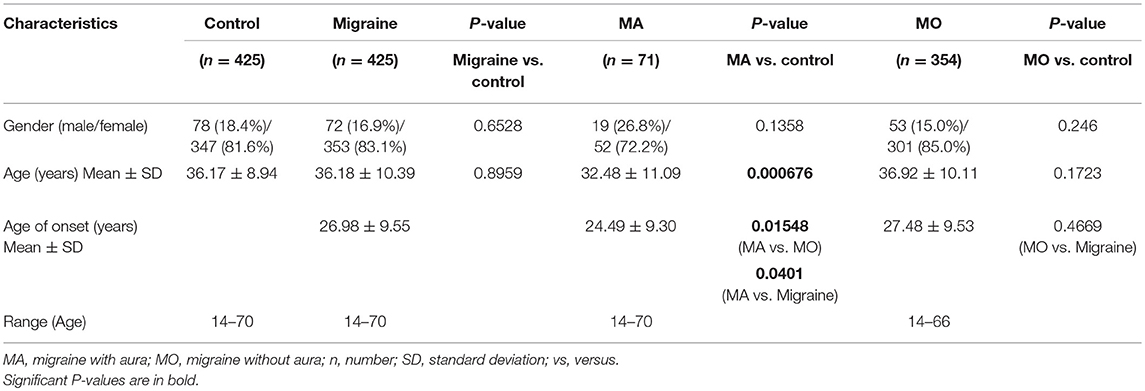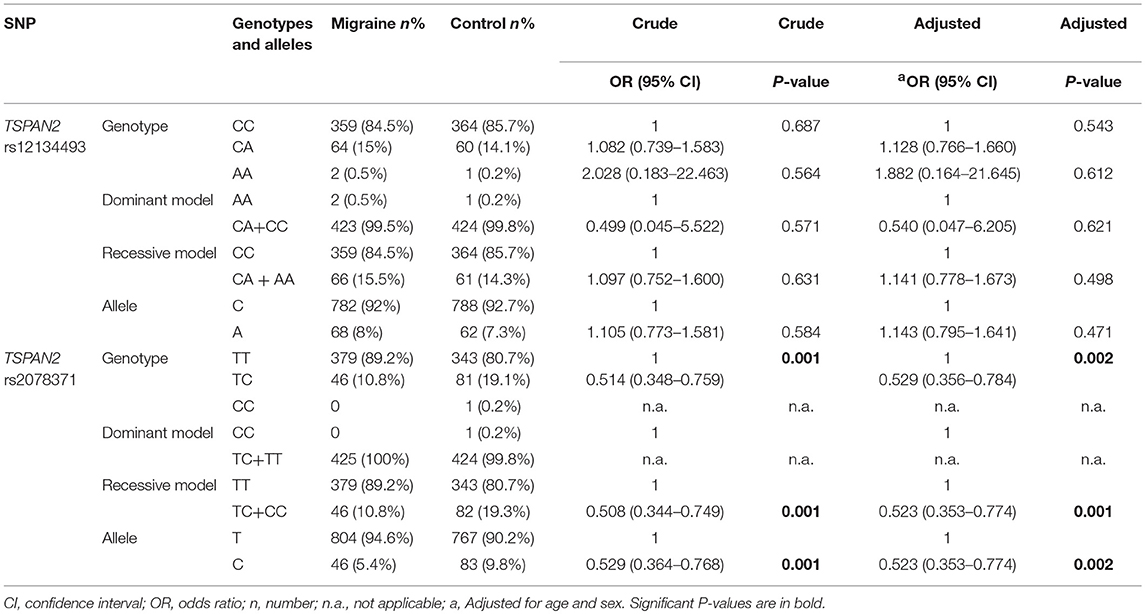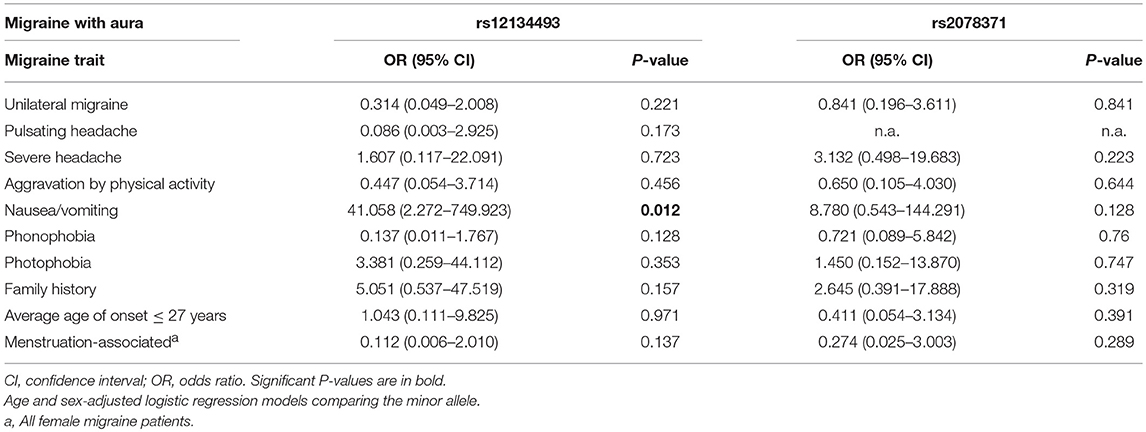- 1Department of Neurology, The First Affiliated Hospital of Xiamen University, Xiamen, China
- 2Department of Gynaecology and Obstetrics, Xiamen Maternal and Child Health Care Hospital, Xiamen, China
- 3Graduate School of Fujian Medical University, Fuzhou, China
- 4Department of Neurology, Zhongshan Xiamen Hospital, Fudan University, Xiamen, China
- 5Fujian Medical University, Fuzhou, China
- 6State Key Laboratory for Medical Genomics, Shanghai Institute of Hematology, Rui-Jin Hospital Affiliated to School of Medicine, Shanghai Jiao Tong University, Shanghai, China
Tetraspanin 2 (TSPAN2) belongs to the tetraspanin superfamily. Previous studies have identified significant associations of the TSPAN2 single nucleotide polymorphisms (SNPs) rs12134493 and rs2078371 with migraine in Western populations; however, these associations need to be confirmed in the Chinese Han population. In addition, we carried out further studies to see whether TSPAN2 is associated with susceptibility to migraine to provide new clinical evidence. A case-control study (425 patients with migraine and 425 healthy controls) in a Chinese Han population was performed to evaluate the associations between migraine and TSPAN2 via a genotype-phenotype analysis between TSPAN2 and clinical symptoms. The SNP rs2078371 was found to be significantly associated with migraines especially in migraines without aura (MO) and in female patients. Meta-analysis revealed that the A allele of rs12134493 was significantly associated with migraines (OR = 1.14, P = 0.0001). Our findings suggested that TSPAN2 is a potential susceptibility factor for migraines. To confirm our results, a large-scale Chinese Han population study should be conducted. Considering that these two SNPs have not been definitively shown to affect TSPAN2 or to regulate nearby genes in this genomic region, the biological function and molecular mechanism of TSPAN2 in migraine should be further explored.
Introduction
Migraine is a complex neurovascular disorder with symptoms including severe headache, nausea, vomiting, photophobia, and phonophobia (1). Almost 14% of the adult population worldwide, and 9.3% of Chinese population in mainland China, are affected by this disease (2, 3). Migraines can be divided into two main subtypes according to The International Classification of Headache Disorders, 3rd edition (ICHD-III) (4): migraine without aura (MO) and migraine with aura (MA). Although a number of epidemiological studies have discovered that migraine has a strong correlation with genetic polymorphisms (5), its etiology and pathogenesis remain poorly understood because of the problematic differential diagnoses.
Approximately 50% of migraine patients have first-degree relatives with the same disorder, and the heritability estimates reported in twin studies ranged from 34 to 57% (6–8). Based on previous studies and the existing theory, the importance of the genetic basis of migraine was fully recognized and systematically proven. In addition, dozens of susceptibility genes related to migraine have been identified by genome-wide association studies (GWASs) conducted in large case-control cohorts (9–11).
Tetraspanin 2 (TSPAN2) is a less well-characterized member of the tetraspanin superfamily, which constitutes 33 cell surface membrane proteins. However, a potential role of TSPAN2 in oligodendrogenesis and in stabilizing the mature sheath (12) has been demonstrated. Anttila et al. conducted a meta-analysis, including 29 studies with 23,285 migraine patients and 95,425 healthy controls (13). Twelve single nucleotide polymorphisms (SNPs) were identified in relation to migraine susceptibility. Among the SNPs, rs12134493 is located upstream of the TSPAN2 gene. Meanwhile, the SNP rs2078371 maps close to the TSPAN2 gene and has been proven to have a significant association with migraine (14).
The Chinese Han people are genetically distinct from other races, with a distinctive lifestyle and different genetic polymorphisms; therefore, our replication study aimed to evaluate the association of the SNPs rs12134493 and rs12134493 with migraine in a Chinese Han population from southern Fujian province, China. Moreover, we investigated the genotype-phenotype association to establish the quantitative correlation, and we assessed the impact of the two SNPs on the migraine phenotype.
Methods
Patients and Samples
The study was approved by the ethics committee of the First Affiliated Hospital of Xiamen University, and it was conducted using clinical samples from patients with migraine who were treated from February 2013 to February 2016. The control group comprised of 425 non-headache, age and gender-matched healthy volunteers who were recruited from the same regional background (southern Fujian province). All of the patients with migraine were diagnosed as suffering either from MA or MO by two headache specialists after neurological examination, direct interview, computed tomography (CT), or magnetic resonance imaging (MRI), according to the diagnostic criteria set by the ICHD-III (4). In addition, the healthy controls had no personal or family history of chronic headache. This study was carried out in accordance with the code of ethics of the World Medical Association (Declaration of Helsinki) for experiments in humans.
Genetic Analysis
Genomic DNA from all subjects was extracted from whole blood samples using 0.5 M ethylene diamine tetraacetic acid (EDTA) as an anticoagulant, using the QiaAmp DNA Mini Kit (Qiagen, Hilden, Germany). The DNA samples were stored at −20°C. Genotyping of rs12134493 and rs2078371 in TSPAN2 was performed using the Multiplex SNaPshot technique (Applied Biosystems by Life Technologies, Foster City, CA, USA). PCR amplifications were performed in a final volume of 25 μl, containing 50 mM MgCl2, 10 mM dNTP, 1 μM primers, and 5 units of Platinum Taq DNA polymerase. The PCR conditions used were 95°C denaturation for 2 min; followed by 33 cycles at 95°C for 20 s, 55°C for 20 s, and 72°C for 40 s; and a final extension step at 72°C for 5 min. The SNaPshot reaction was performed in a final volume of 5 μl (reaction mix 2.5 μl, PCR products 1.5 μl, and probe mix 1.0 μl). DNA sequencing was performed in a final volume of 10 μl containing 1 μl of SNaPshot purified product, 8.5 μl of deionized formamide, and 0.5 μl GeneScan-120 LIZ Size Standard, using an ABI PRISM 3730 DNA Sequencer (Applied Biosystems by Life Technologies). All sequence analyses were performed using GeneMapper4.0 DNA Sequencing Analysis software.
Statistical Analysis
SHEsis software (http://analysis.bio-x.cn/myAnalysis.php) was used to calculate the Hardy-Weinberg equilibrium (HWE), linkage disequilibrium blocks, and haplotype association risk (15). SPSS version 20.0 (IBM Corp., New York, NY, USA) was used for all the statistical analyses. The chi-squared test or t-test was used to compare age and gender among the groups; allele and genotype frequencies were compared using the chi-squared test. The genotypes of each SNP were also assessed according to dominant [AA vs. AB + BB (A, major allele; B, minor allele)] or recessive (AA + AB vs. BB) models. The odds ratio (OR) and its corresponding 95% confidence interval (CI) were used as estimates of the association between case-control status and each polymorphism using an unconditional multiple logistic regression model, both with and without adjustment for sex and age. The genotype-phenotype correlation was estimated using the OR and 95% CI from logistic regression analyses with adjustment for sex and age. The R software was used to perform the meta-analysis in the META package (16). The heterogeneity of intervention effects among the studies was evaluated using Cochrane's test. Significant heterogeneity was considered if P < 0.05 with the I2 statistic test, where the I2 cutoff values were 25, 50, and 75% for low, moderate, and high heterogeneities, respectively. P values were adjusted for multiple testing using the Bonferroni correction; therefore, we used P < 0.05/5 = 0.01 as a threshold for significance.
Results
Subject Demographic Analysis
The characteristics of the patients with migraine and the controls involved in this study are presented in Table 1. The subjects' demographics did not differ significantly between the patients with migraine and controls, with respect to gender and age (P = 0.6528/0.8959). The mean ± SD for age was 36.18 ± 10.39 years for the patients with migraine (range 14–70) and 36.17 ± 8.94 years for the controls (range 14–70). Patients were classified into two groups, including MA (N = 71, 52 females and 19 males; mean age: 32.48 ± 11.09) and MO (N = 354, 301 females and 53 males; mean age: 36.92 ± 10.11).
Association of TSPAN2 SNP (rs12134493) With Migraine
The CC, CA, and AA genotype frequencies of the TSPAN2 SNP rs12134493 were 85.7, 14.1, and 0.2% in the controls and 84.5, 15, and 0.5% in the patients, respectively. The allele frequencies of the TSPAN2 SNP rs12134493 were 92.7% (C) and 7.3% (A) in the controls and 92% (C) and 8% (A) in the patients (Table 2). The genotype frequencies of the controls and patients were both consistent with the HWE (P = 0.366/0.635). The distribution of the TSPAN2 CA polymorphism was not significantly different between the patients and the controls, before and after adjustment for age and sex (crude OR = 1.082, P = 0.687/adjusted OR = 1.128, P = 0.543), as it was for the AA polymorphisms (crude OR = 2.028, P = 0.564/adjusted OR = 1.882, P = 0.612) and the A allele (crude OR = 1.105, P = 0.584/adjusted OR = 1.143, P = 0.471) (Table 2). In addition, there was no association between migraine subtypes (MA/MO) or gender subtypes and the TSPAN2 SNP rs12134493 in this population (Tables 3, 4).
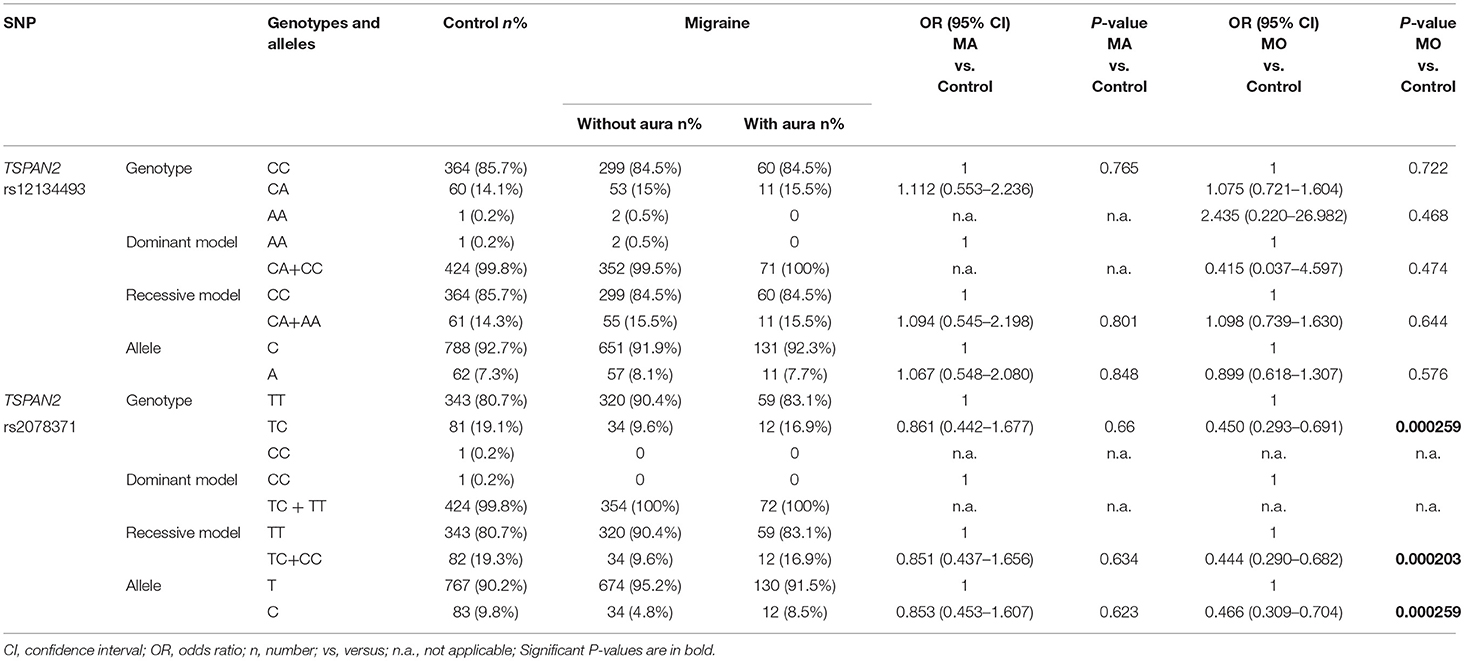
Table 3. Genotype and allelic frequencies of the TSPAN2 SNPs in patients with different migraine subtypes.
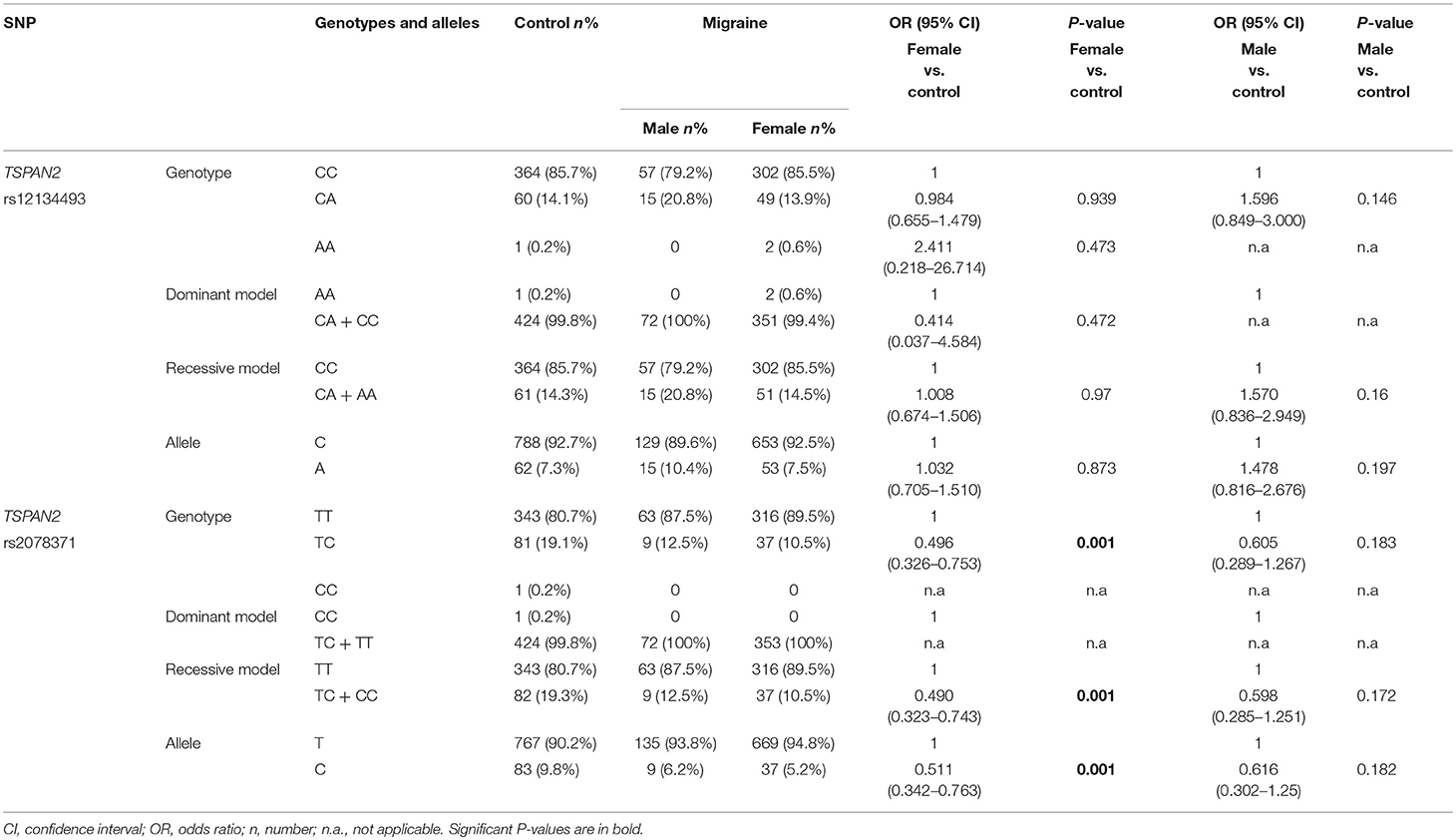
Table 4. Genotype and allelic frequencies of the TSPAN2 SNPs in patients with different gender subtypes.
Association of TSPAN2 SNP (rs2078371) With Migraine
The TT, TC, and CC genotype frequencies of the TSPAN2 SNP rs2078371 were 80.7, 19.1, and 0.2% in the controls and 89.2, 10.8, and 0 in the patients, respectively. The allele frequencies of the TSPAN2 SNP rs2078371 were 90.2% (T) and 9.8% (C) in the controls and 94.6% (T) and 5.4% (C) in the patients (Table 2). The genotype frequencies of the controls and patients were both consistent with the HWE (P = 0.093/0.238). The distribution of the TSPAN2 TC polymorphism was significantly different between patients and controls, before and after adjustment for age and sex (crude OR = 0.514, P = 0.001/adjusted OR = 0.529, P = 0.002), as it was for the C allele (crude OR = 0.529, P = 0.001/adjusted OR = 0.523, P = 0.002). In addition, an association was detected for the TC genotype between the MO subgroup and the controls (crude OR = 0.450, P = 0.000259) and for the T allele (crude OR = 0.466, P = 0.000259). Moreover, an association was also detected for the TC genotype between the female subtype and the controls (crude OR = 0.496, P = 0.001) and for the C allele (crude OR = 0.511, P = 0.001). In conclusion, the C allele of the TSPAN2 SNP rs2078371 could decrease the risk of migraine, and the T allele would increase such risks. The TC genotype could be considered a risk factor for migraine headaches, especially the MO type, and females with the TC genotype are at a higher risk than males.
Meta-Analysis
Eleven studies, including our data and results from the previous reports, were subjected to a meta-analysis using a random-effect or fixed-effect model (8, 13, 14, 17–19). The A allele of the SNP rs12134493 reached genome-wide significance in migraine, with a pooled OR of 1.14 (P = 0.0001) and nonsignificant heterogeneity (I2 = 32%, P = 0.2102). While the C allele of the SNP rs2078371 failed to reach the significance level, with a pooled OR of 1.08 (P = 0.0954) and a high heterogeneity (I2 = 68%, P = 0.0045) (Figure 1).
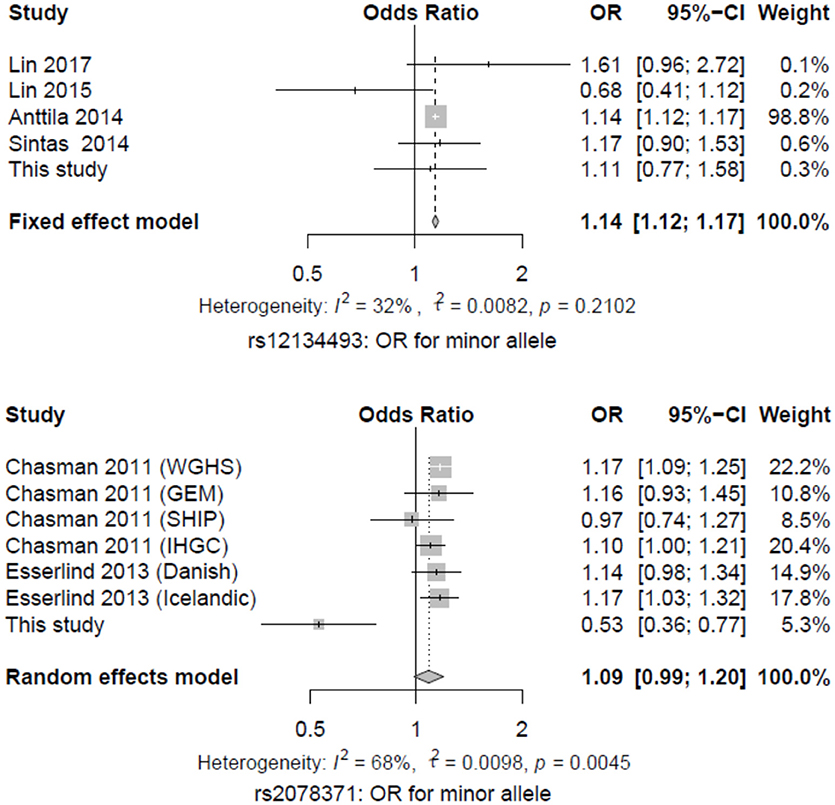
Figure 1. Forest plot of migraine risk associated with the two SNPs in TSPAN2. The estimates of ORs and 95% CIs were plotted with a box and a horizontal line.
Linkage Disequilibrium (LD) Tests
The pairwise linkage disequilibrium (LD) between the two SNPs is shown in Table 5. Haplotype analysis in both patients and controls revealed a strong pairwise LD between the rs12134493 and rs2078371 polymorphisms (D' = 0.717, r2 = 0.509). The frequencies of the haplotypes are listed in Table 5, which shows that the frequency of the A-T haplotype is higher in the patients with migraine (P = 0.007, OR = 2.728), while the C-C haplotype is more frequent in the healthy controls (P = 1.98e-006, OR = 0.099). This result suggested that the A-T haplotype increases susceptibility to migraine, while the C-C haplotype is a protective factor.

Table 5. Linkage disequilibrium and distribution of haplotypes of the two SNPs in TSPAN2 between the cases and controls.
Genotype-Phenotype Analysis
Genotypes and substantial clinical data from the electronic patient records were available for 425 patients with migraines. None of the migraine features showed a statistically significant correlation with the two SNPs in the migraine group and the MO subgroup (Tables S1, S2). Comparing the minor allele with the maximal allele of the SNP rs12134493 revealed a nominally significant correlation between nausea/vomiting and the MA subgroup (OR = 41.058, P = 0.012) (Table 6). However, it did not show a compelling trend after correction for multiple comparisons.
Discussion
The biological function of TSPAN2 in different human diseases and in related tissues remains unclear (20–22). Although studies have revealed that TSPAN2 is involved in tumor metastasis and invasiveness in human lung adenocarcinomas, notably in malignancy (23), further studies are required. In addition, TSPAN2 is highly expressed in oligodendrocyte lineage cells, and it may regulate the differentiation of oligodendrocytes into myelin-forming glia, which suggested that TSPAN2 could have an association with migraine (12, 24). Previous studies, including GWAS findings, identified the SNPs rs12134493 and rs2078371 of TSPAN2 as being associated with migraine susceptibility. However, these studies focused mainly on Caucasians. The current study evaluated the association of the two SNPs with migraine in a Chinese Han population from southern Fujian province, China.
Anttila et al. proved the association of rs12134493 with migraine in a Western population (13). Subsequently, Sintas et al. replicated this study and identified that rs12134493 was nominally associated with migraine in a Spanish population (16). In contrast to these studies, we failed to replicate the association between the rs12134493 polymorphism and migraine, even in the subtype analysis. In addition, our findings are consistent with those of Lin et al. in another Chinese Han population (19). Furthermore, combining these studies in a meta-analysis showed that the A allele of the SNP rs12134493 reached genome-wide statistical significance for migraine (P = 0.0001). The evidence indicated that the association of this variant depends on race and/or ethnicity.
A GWAS study by Chasman et al. and another study by Esserlind et al. identified that the SNP rs2078371 reached genome-wide significance for an association with migraine in Western populations (8). Our findings also supported the view that rs2078371 could be a susceptibility factor for migraine, especially for MO and in females. However, in the present study, this SNP showed a high degree of allelic heterogeneity when compared with those in previous studies. This result is probably caused by the difference in minor allele frequency (MAF) in the Chinese Han population versus the Caucasians, according to 1,000 Genomes Project data (25).
We analyzed the haplotypes of the loci and noticed that the two haplotypes of the four loci of the TSPAN2 are statistically significant (P < 0.01). This suggested that the C-C haplotype is a protective factor for the development of migraine, and it may reduce morbidity risk in this ethnic group. By contrast, the A-T haplotype increases the risk of suffering from migraine by 2.728-fold. In addition, the genotype-phenotype analysis did not provide any evidence of the association of the two susceptibility variants with migraine traits among the migraine group or the MO subtype. Analysis of the MA subtype with the rs12134493 SNP locus revealed a nominal correlation with nausea/vomiting, which did not show a compelling trend after correction for multiple comparisons. Furthermore, the genotype-phenotype analysis might have been underpowered because of the small sample size adopted by this study and the stringent corrections of multiple testing.
In conclusion, we performed a replicate study to identify the associations between the TSPAN2 SNPs rs12134493 and rs2078371 and migraine in a Chinese Han population. Our findings suggested that rs2078371 could be a potential susceptibility factor for migraine, especially for female sufferers and those with MO. No significant association between rs12134493 and migraine was discovered. The haplotypes analysis showed that the C-C haplotype is a protective factor for migraine, and A-T is a susceptible haplotype. We did not detect any significant influence of these variants on typical migraine symptoms; therefore, their functions remain to be identified. Considering the consistencies and discrepancies between our findings and those of previous studies, a large-scale Chinese Han population study should be conducted to validate the role of TSPAN2 (26, 27). In addition, considering that these two SNPs have not been shown to affect TSPAN2 or to regulate nearby genes within this genomic region, we believe that it is necessary to reveal the biological function and molecular mechanism of TSPAN2 in migraine by integrating genetic, phenotypic, and epigenetic analysis in further research (28).
Ethics Statement
This study conformed to the standards set by the latest revision of the Declaration of Helsinki and was approved by the Ethics Committee of The First Affiliated Hospital of Xiamen University. Written informed consent was obtained from the patients for the publication of this case report.
Author Contributions
JF carried out the molecular genetic studies, performed the statistical analysis, and drafted the manuscript. XA, HQ, XY, CW, GH, LZ, KY and SC carried out the acquisition of data. XW helped to draft the manuscript. QM conceived the study, and participated in its design and coordination. All authors read and approved the final manuscript.
Funding
This study was supported by the National Natural Science Foundation of China (No.81400912), Science and Technology Major Program of Xiamen (No.3502Z20171005-20170801), Fujian Medical Technology Innovation Programs (No.2014-CXB-33), Xiamen Important Joint Research Project of Major Diseases (No.3502Z20149028), Science and Technology Program of Xiamen (No.3502Z20154014), and the First Affiliated Hospital of Xiamen University Research and Development Foundation for Youths (XYY2016012).
Conflict of Interest Statement
The authors declare that the research was conducted in the absence of any commercial or financial relationships that could be construed as a potential conflict of interest.
Supplementary Material
The Supplementary Material for this article can be found online at: https://www.frontiersin.org/articles/10.3389/fneur.2018.00714/full#supplementary-material
References
1. Silberstein SD. Migraine pathophysiology and its clinical implications. Cephalalgia (2004) 24(Suppl. 2):2–7. doi: 10.1111/j.1468-2982.2004.00892.x
2. Bigal ME, Lipton RB. The epidemiology, burden, and comorbidities of migraine. Neurol Clin. (2009) 27:321–34. doi: 10.1016/j.ncl.2008.11.011
3. Yu S, Liu R, Zhao G, Yang X, Qiao X, Feng J, et al. The prevalence and burden of primary headaches in China: a population-based door-to-door survey. Headache (2012) 52:582–91. doi: 10.1111/j.1526-4610.2011.02061.x
4. Headache Classification Committee of the International Headache S. The international classification of headache disorders, 3rd edition (beta version). Cephalalgia (2013) 33:629–808. doi: 10.1177/0333102413485658
5. Gasparini CF, Sutherland HG, Griffiths LR Studies on the pathophysiology and genetic basis of migraine. Curr Genomics (2013) 14:300–15. doi: 10.2174/13892029113149990007
6. Cargnin S, Viana M, Mittino D, Bellomo G, Tassorelli C, Nappi G, et al. Lack of association between GRIA1 polymorphisms and haplotypes with migraine without aura or response to triptans. Neurol Sci. (2014) 35:421–7. doi: 10.1007/s10072-013-1535-1
7. Schurks M. Genetics of migraine in the age of genome-wide association studies. J Headache Pain (2012) 13:1–9. doi: 10.1007/s10194-011-0399-0
8. Esserlind AL, Christensen AF, Le H, Kirchmann M, Hauge AW, Toyserkani NM, et al. Replication and meta-analysis of common variants identifies a genome-wide significant locus in migraine. Eur J Neurol. (2013) 20:765–72. doi: 10.1111/ene.12055
9. Ayata C. Migraine: treasure hunt in a minefield - exploring migraine with GWAS. Nat Rev Neurol. (2016) 12:496–498. doi: 10.1038/nrneurol.2016.118
10. Nyholt DR, van den Maagdenberg AM. Genome-wide association studies in migraine: current state and route to follow. Curr Opin Neurol. (2016) 29:302–8. doi: 10.1097/WCO.0000000000000316
11. Tolner EA, Houben T, Terwindt GM, de Vries B, Ferrari MD, van den Maagdenberg AM. From migraine genes to mechanisms. Pain (2015) 156 (Suppl 1):S64–74. doi: 10.1097/01.j.pain.0000460346.00213.16
12. Yaseen IH, Monk PN, Partridge LJ. Tspan2: a tetraspanin protein involved in oligodendrogenesis and cancer metastasis. Biochem Soc Trans. (2017) 45:465–75. doi: 10.1042/BST20160022
13. Anttila V, Winsvold BS, Gormley P, Kurth T, Bettella F, McMahon G, et al. Genome-wide meta-analysis identifies new susceptibility loci for migraine. Nat Genet. (2013) 45:912–7. doi: 10.1038/ng.2676
14. Chasman DI, Schurks M, Anttila V, de Vries B, Schminke U, Launer LJ, et al. Genome-wide association study reveals three susceptibility loci for common migraine in the general population. Nat Genet. (2011) 43:695–8. doi: 10.1038/ng.856
15. Shi YY, He L. SHEsis, a powerful software platform for analyses of linkage disequilibrium, haplotype construction, and genetic association at polymorphism loci. Cell Res. (2005) 15:97–8. doi: 10.1038/sj.cr.7290272
16. Schwarzer G, Carpenter J, Rücker G. Mate-Analysis with R. Cham: Springer International Publishing (2015).
17. Sintas C, Fernandez-Morales J, Vila-Pueyo M, Narberhaus B, Arenas C, Pozo-Rosich P, et al. Replication study of previous migraine genome-wide association study findings in a Spanish sample of migraine with aura. Cephalalgia (2015) 35:776–82. doi: 10.1177/0333102414557841
18. Lin QF, Chen ZC, Fu XG, Yang J, Cao LY, Yao LT, et al. Migraine susceptibility genes in Han Chinese of Fujian Province. J Clin Neurol. (2017) 13:71–6. doi: 10.3988/jcn.2017.13.1.71
19. Lin QF, Fu XG, Yao LT, Yang J, Cao LY, Xin YT, et al. Association of genetic loci for migraine susceptibility in the she people of China. J Headache Pain (2015) 16:553. doi: 10.1186/s10194-015-0553-1
20. Hemler ME. Targeting of tetraspanin proteins–potential benefits and strategies. Nat Rev Drug Discov. (2008) 7:747–58. doi: 10.1038/nrd2659
21. Hemler ME. Tetraspanin proteins promote multiple cancer stages. Nat Rev Cancer (2014). 14:49–60. doi: 10.1038/nrc3640
23. Otsubo C, Otomo R, Miyazaki M, Matsushima-Hibiya Y, Kohno T, Iwakawa R, et al. TSPAN2 is involved in cell invasion and motility during lung cancer progression. Cell Rep. (2014). 7:527–38. doi: 10.1016/j.celrep.2014.03.027
24. de Monasterio-Schrader P, Patzig J, Mobius W, Barrette B, Wagner TL, Kusch K, et al. Uncoupling of neuroinflammation from axonal degeneration in mice lacking the myelin protein tetraspanin-2. Glia (2013) 61:1832–47. doi: 10.1002/glia.22561
25. Genomes Project C, Abecasis GR, Altshuler D, Auton A, Brooks LD, Durbin RM, et al. A map of human genome variation from population-scale sequencing. Nature (2010) 467:1061–73. doi: 10.1038/nature09534
26. Wabnitz A, Bushnell C. Migraine, cardiovascular disease, and stroke during pregnancy: systematic review of the literature. Cephalalgia (2015) 35:132–9. doi: 10.1177/0333102414554113
27. Pizza V, Agresta A, Agresta A, Lamaida E, Lamaida N, Infante F, et al. Migraine and genetic polymorphisms: an overview. Open Neurol J. (2012) 6:65–70. doi: 10.2174/1874205X01206010065
Keywords: migraine, Tetraspanin 2, TSPAN2, SNP, genotype-phenotype analysis
Citation: Fang J, Yuan X, An X, Qu H, Wang C, Hong G, Zheng L, Yi K, Chen S, Wang X and Ma Q (2018) Involvement of the Tetraspanin 2 (TSPAN2) Gene in Migraine: A Case-Control Study in Han Chinese. Front. Neurol. 9:714. doi: 10.3389/fneur.2018.00714
Received: 24 May 2018; Accepted: 08 August 2018;
Published: 11 September 2018.
Edited by:
Massimiliano Valeriani, Bambino Gesù Ospedale Pediatrico (IRCCS), ItalyReviewed by:
Sabina Cevoli, Università degli Studi di Bologna, ItalyWilliam Renthal, Brigham and Women's Hospital, Harvard Medical School, United States
Copyright © 2018 Fang, Yuan, An, Qu, Wang, Hong, Zheng, Yi, Chen, Wang and Ma. This is an open-access article distributed under the terms of the Creative Commons Attribution License (CC BY). The use, distribution or reproduction in other forums is permitted, provided the original author(s) and the copyright owner(s) are credited and that the original publication in this journal is cited, in accordance with accepted academic practice. No use, distribution or reproduction is permitted which does not comply with these terms.
*Correspondence: Xinrui Wang, wanxiruqiqi@sina.com
Qilin Ma, qilinma@yeah.net
† These authors have contributed equally to this work share first authorship
 Jie Fang
Jie Fang Xiaodong Yuan2†
Xiaodong Yuan2† Chen Wang
Chen Wang